Men's suits have gone through a lot of changes over the years. While you may find some of the changes very little, others are more significant. Here's how men's suits evolved over the years.
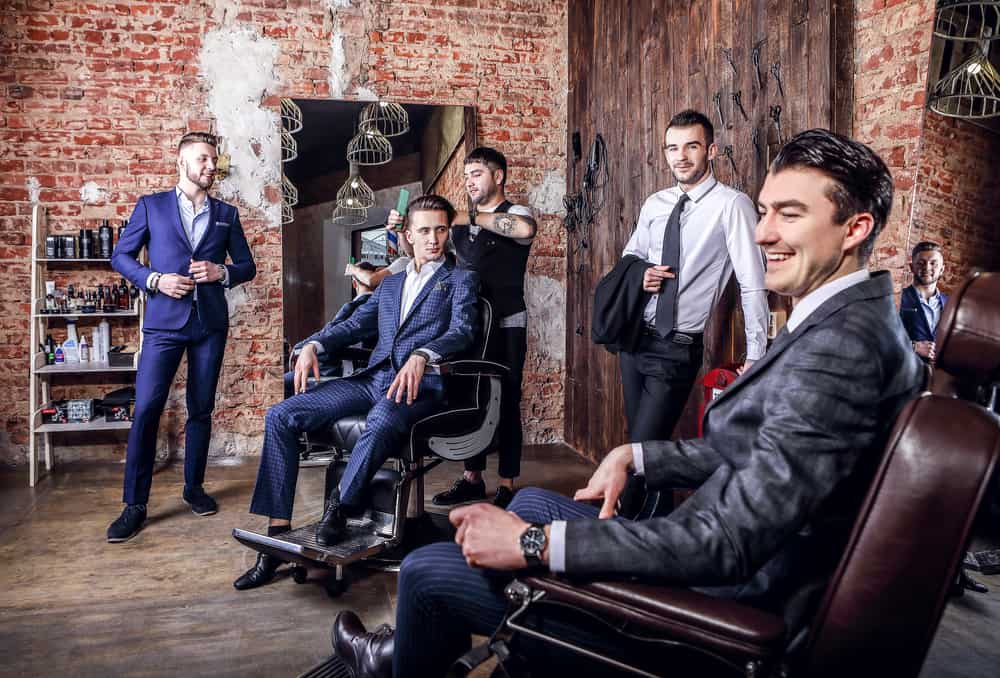
Go to your TV or device, turn on any movie and at some point, it’s incredibly likely that you’ll see a man wearing a classic suit. You know what it looks like: a three-button jacket with a pair of pants in the same color and material. Men wore them in the 1920s and they wear them in the 2020s. But how long has this classic fashion item been around, who actually created it and how has it changed over the years?
You may think men’s suits have been the same for a century or more. But in fact, there have been many changes and innovations to the suit over the years. When you know what to look for, you’ll know how to tell when and even where a suit was made.
Table of Contents
- Overview
- 1660s
- 1790s
- 1800s
- 1810s
- 1820s
- 1830s
- 1840s
- 1850s
- 1860s
- 1870s
- 1880s
- 1890s
- 1900s
- 1910s
- 1920s
- 1930s
- 1940s
- 1950s
- 1960s
- 1970s
- 1980s
- 1990s
- 2000s
- 2010s
- 2020s
- Suit styles
Overview
The classic men’s suit actually wasn’t made popular by some fancy king or someone with a lot of money. It wasn’t first worn by a big-time actor, a famous athlete, a writer or a musician. The men’s suit was created by a pretty normal guy who became well-known for his trendsetting style. And he invented the look much sooner than you probably think, for reasons that may surprise you. This history of suits is filled with interesting stories.
1660s

Many fashion experts trace the origins of the suit back to the 1660s and a man who was known for his extreme and elaborate style: Charles II, King of England. His biggest claim to the history of suits is the introduction of the vest into everyday styles, something he actually did to help the English wool trade and to break from French fashion.
The vest was tight-fitting and knee-length, unlike the short vests that are more known in modern style. The tough wool vest was a departure from the delicate lace and muslin materials that were worn under jackets before this. The vest, or waistcoat, would become an essential part of the suit much later in fashion history.
King Charles II merely planted the seed for the suit before it was common to wear trousers. For the suit to truly be born in the fashion world, it would take another Englishman in a much later era.
1790s
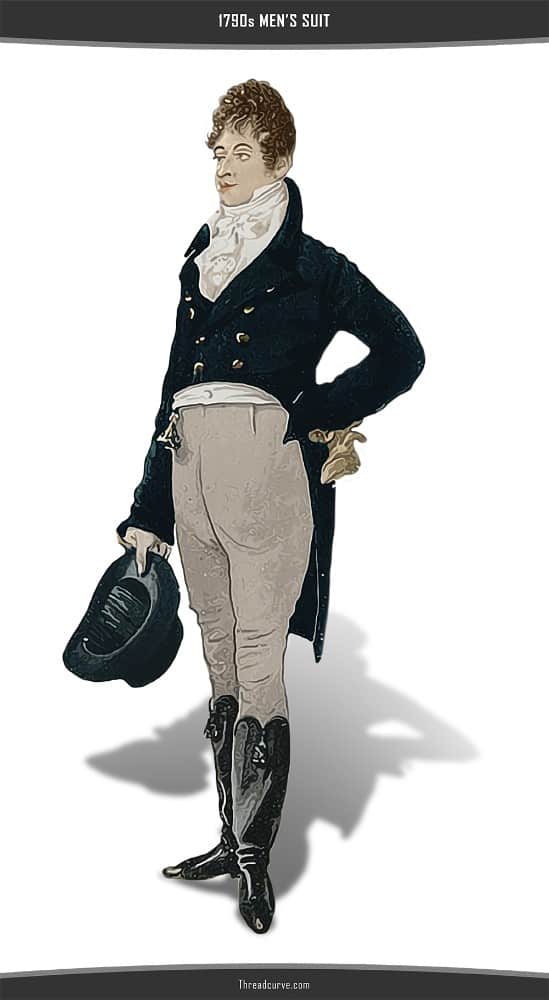
There are trendsetters…and then there’s Beau Brummell. He was incredibly popular, very well-known, totally connected to all the right people and he was the type of guy who didn’t follow the fashion trends. He set them. Most people credit him for the creation of the modern men’s suit.
Fashion at the time was sort of over-the-top. Men’s fashion of the day was heavily influenced by the French court. Fabrics were thick and heavily embroidered and men mostly wore knee breeches, stockings and highly embellished jackets with tails, rather than the trousers that are more familiar today. Under all this were highly elaborate shirts with ruffles. This was a time when men were still putting on a powdered wig to top off their daily looks. But this was slowly changing, as people craved a more simplified style. One man was brave enough to actually do it.
Setting the trend
Brummel decided to create his own style. He simplified all this and chose more muted colors, wearing a jacket that was far less embellished than popular styles of the day, and a pair of long pants, or trousers. The jacket and pants weren’t a perfect match yet, but this was the beginning of the men’s suit as it’s known today.
Brummel ditched the stockings and put on long, tailored trousers with a simple dark jacket with tails and an elegant white waistcoat. It was a very different look from what everyone else was wearing…and everyone else definitely noticed.
After he showed off his new look, everyone wanted to copy him. It certainly didn’t hurt that Brummel was good friends with Prince George, the man destined to become King George IV. Everyone paid attention to what he wore and his style was quickly copied. The jacket and long pants combo caught on. Essentially, Beau Brummell popularized the very idea of wearing a suit at all. When you think about all the suits that have been worn in the decades since and the fact that it was all started by just one guy who didn’t want to wear stockings, it’s pretty shocking how fashion works!
The cost of fashion
Though he has gone down in history as the grandfather of all modern men’s style, there is a cost for fashion. Brummell couldn’t really afford to wear a lot of fine clothing. He was friends with royalty and nobility but he wasn’t one of them and didn’t have their income. As a result, all his fashion put him deeply into debt. He had to flee England and live in France to avoid his creditors. He was penniless when he died in 1840, a man who once rubbed elbows with the future King of England and set the style trends for 200 years.
So the next time you buy a suit you can’t afford, don’t think of it as a bad decision. Think of it as something that trendsetter Beau Brummell would likely approve of.
1800s
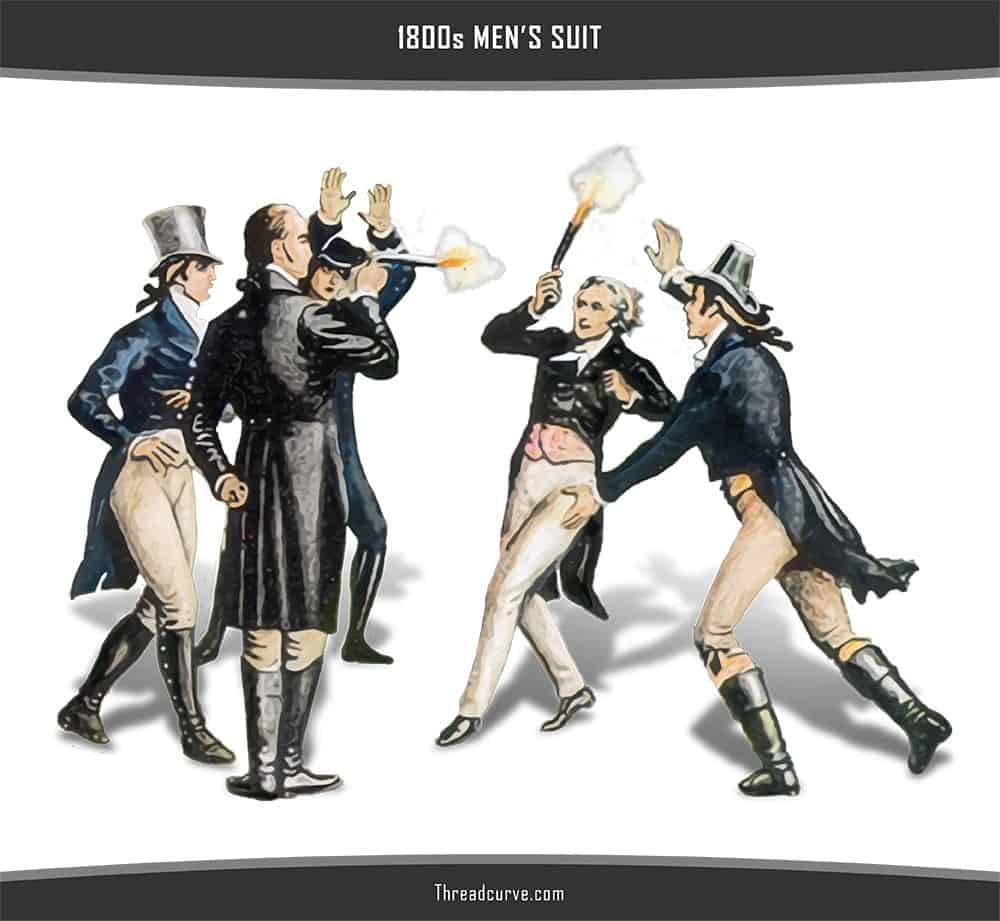
The first tailor was opened up on Savile Row, which today is the center of London fashion. Tailoring techniques had become more refined and more styles were possible, allowing men to request specific looks and modify the popular styles of the day to suit their own tastes. Soon, Savile Row tailors became known for their trendy fashion and many options.
It was the style to wear pants somewhat loose and right at ankle-length. Pants, known mostly as trousers, were becoming more popular than both pantaloons and breeches in this decade, which would set the tone for all men’s fashion of the future.
Trousers sat high on the waist and jackets were heavily tailored in asymmetrical styles with tails in the back. Jackets were short in front, sometimes even exposing the shirt underneath. Sleeves were worn long and shirt collars were worn high. Cravats were the finishing touch of choice for neckwear in this decade.
1810s
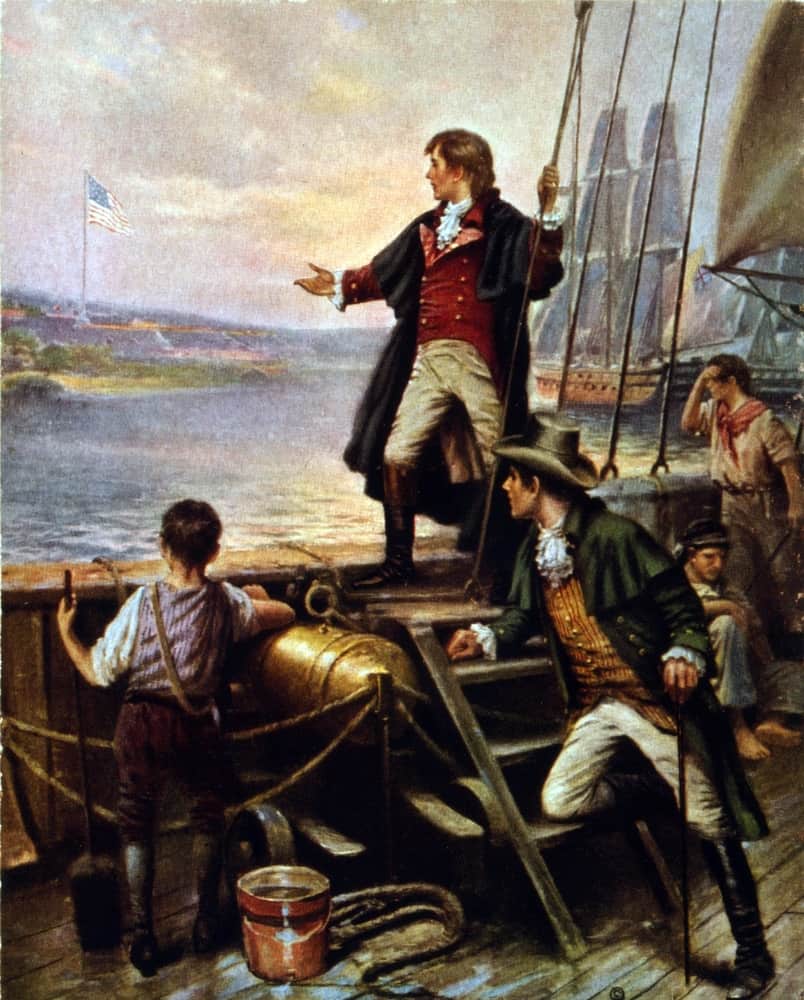
Tailors began making unembellished, streamlined jackets in keeping with the style popularized by Brummel. The jackets were made with curving collars and flat lapels in a style that would later inform the modern suit look. Wool was used most often to create the jackets.
Pants were worn with loops at the bottom that went under the foot and large, knee-length jackets were popular. It was still more common to wear a jacket and trousers in two different colors. At this time, black and blue jackets were the height of fashion. Waistcoats were typically light-colored. Jackets were short in front and had long, almost knee-length tails in the back.
1820s

Longer waistcoats were in style in this decade. Pants were worn with stirrups that fit under the shoes and were often worn in a different color than the jacket. Shirts were made of white muslin. White waistcoats and neckcloths were also in fashion. It was easy to get white dirty, so to wear it became something of a status symbol. A man was showing that he could afford to keep his white garments clean. Shirts were frilled, collars were tall and cravats were in fashion.
Ready-made clothing was widely available for purchase for the first time in this decade thanks to recent inventions, such as the cotton gin in 1794 and the mechanized loom in 1801. Custom-made, tailored clothing was also popular at this time. This meant that clothes were available in a wider range of colors and styles exploded with different hues. Even evening clothes were brightly colored and vivid at this time.
Waistlines were high, up to the belly button, and breeches were now completely out of fashion. Pants were the look of choice now.
1830s
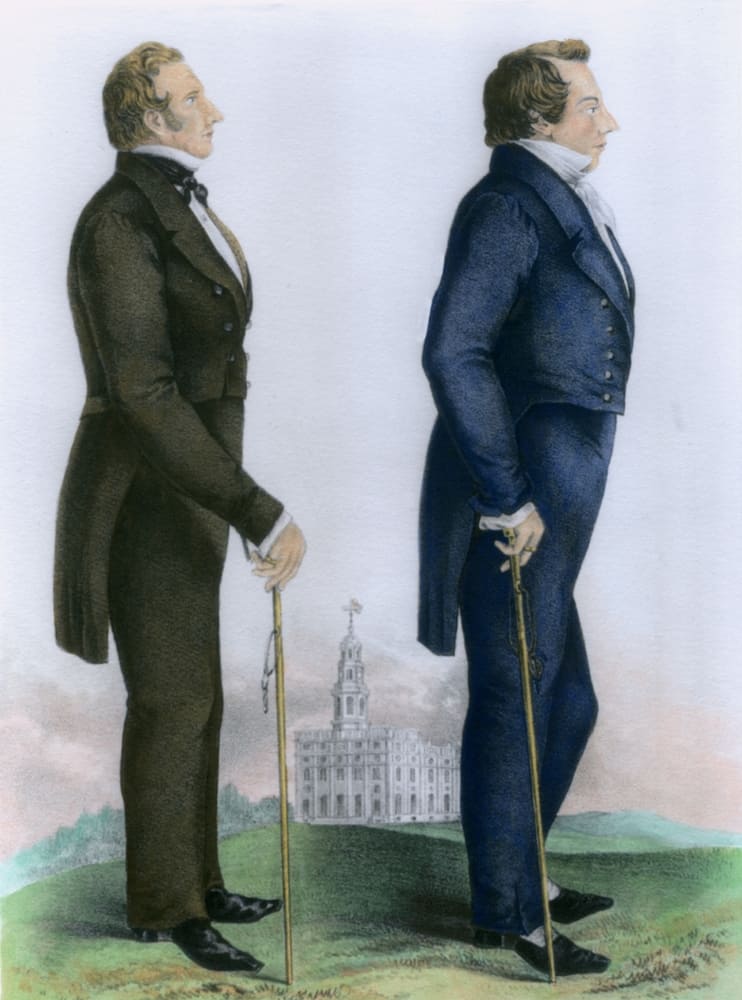
Suits were worn for everyday and formal occasions. Jackets were very short in front, sitting at the waist, with long tails in the back that went past the hips. Jackets were commonly double-breasted with very wide lapels. Pants were cut to fit slim. Padding or multiple vests were worn under the jacket to make the chest look bigger. This contrasted with the waist, which made it look even slimmer.
At this time, jackets were mostly made in darker shades of black, blue, green, wine red and brown. The jackets had two buttons at the back, so the tails could be buttoned up while riding in a saddle.
1840s
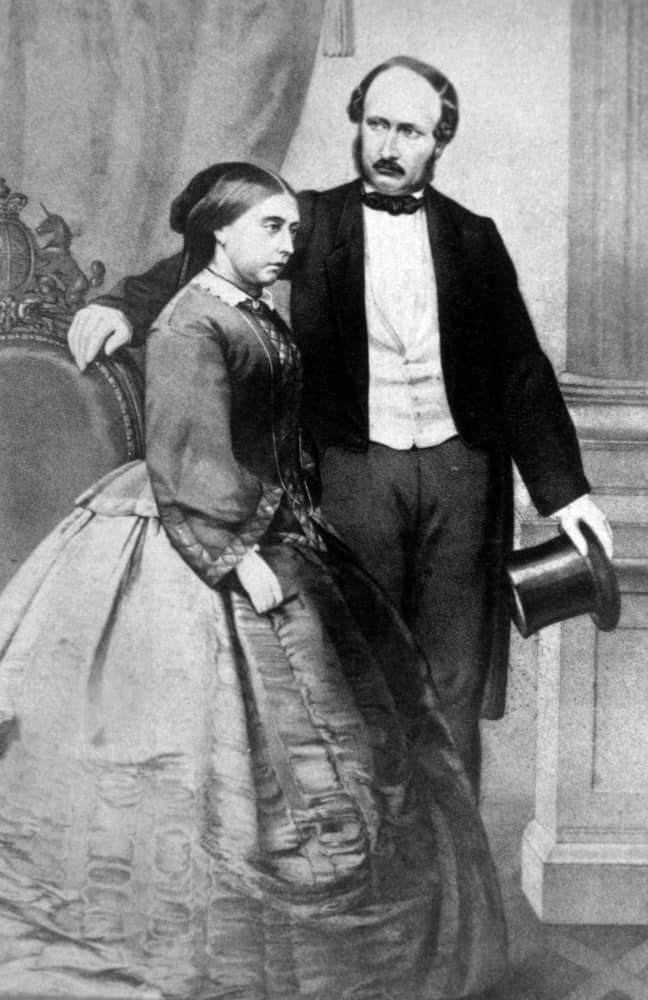
Suit jackets were buttoned low and tightly cinched at the waist in this decade. They flared out from the waist and had a rounded chest that created an hourglass silhouette. Prince Albert popularized this cinched waist look. This jacket style became known as the frock coat and remained popular throughout the Victorian Era.
Frock coat styles would continue to be seen for the next six decades. They are still worn in very formal attire and to this day, members of the British royal family wear frock coat styles for royal weddings and other big events.
Pants were also very fitted at this time. Shirt collars were stiff and tall.
Suit jackets were worn long, nearly to the knees. Lapel styles were short and wide. All the most fashionable men of the era finished their suits with a top hat and carried a cane.
1850s
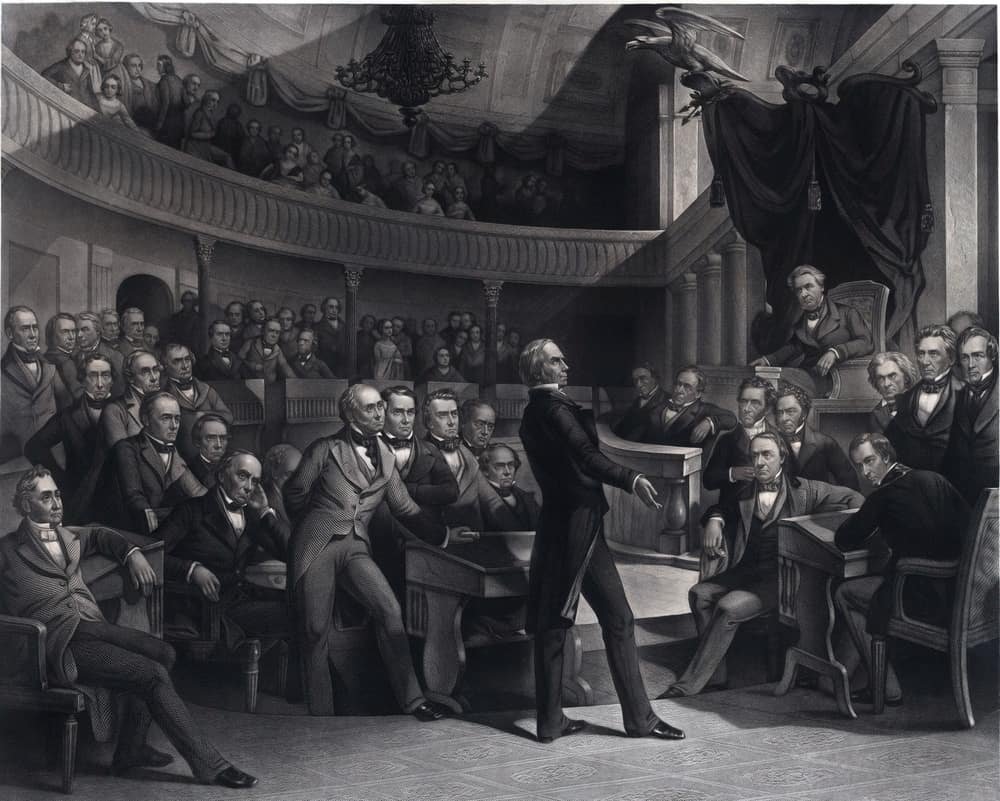
In Scotland, the lounge suit was invented. Made in heavier fabric, this suit was perfect for the chilly Scottish weather. It was a casual garment worn for sport and outdoor recreation. Lapels were wide but short and jackets were tapered and close-fitting, with multiple buttons at the ends of the sleeves and pockets on the waist. This was the beginning of the sack suit style, which has never fallen far out of fashion since its creation. The sack suit is a somewhat loose, three-piece suit that is a version of a modern lounge suit.
The main characteristic of the lounge suit was the matching fabric of the jacket and pants. This is why the lounge suit was also called “dittoes.”
Being in style
Tall, stiff shirt collars continued to be popular in this decade. Suit jackets were made in the so-named sack coat style because they were loose-fitting. They fell to about thigh-length. Most often, suits of this decade were finished with top hats.
Pants were usually worn without creases at this time in long, straight styles. It was fashionable to wear double-breasted vests and it was fashionable to wear checked styles. The trousers did not match the vest, making the vest the focal point of the suit. Lapels were wide with high, deep notches.
1860s
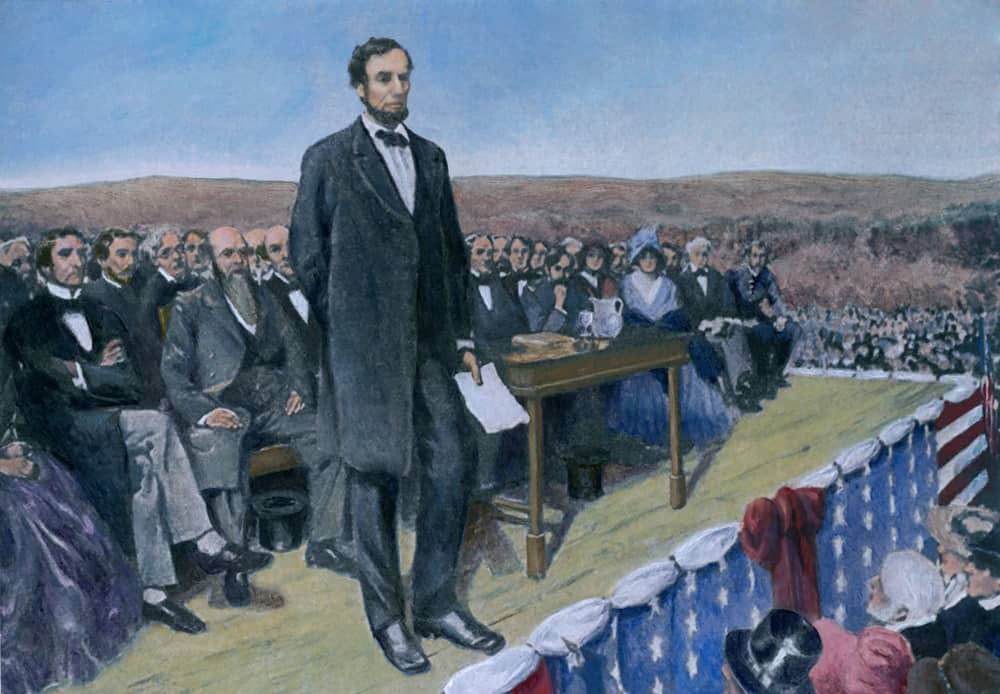
Men’s suit jackets were single-breasted and slim-fitting in this decade. Jackets were still sitting about mid-thigh in the popular frock coat style and they were worn with single-breasted waistcoats. Black was in and most men were wearing jackets in this shade. It was popular to wear it with a white vest. Striped pants were all the rage in this decade. They were made in more slim-fit styles, falling slightly past the ankle.
Many men in this decade were in uniform, as the early part of the 1860s saw the Civil War play out in the U.S. Uniform pieces continued to be seen throughout the decade.
1870s

Jackets and waistcoats were both buttoned high on the chest at this time, paired with stiff shirt collars. The tips of the tall collars were turned down just a little to create short wings. Jackets were still long, falling to the thighs, as the frock coat was still a predominant look.
Cummerbunds found their way into European fashion at this time thanks to English officers in East India. They adopted the style of wearing a sash around the waist, rather than a waistcoat. Officers brought the look back home with them, where it was quickly dismissed as “slovenly” and “vulgar.” The cummerbund was worn by some fashion rebels until 1895. By then, it was considered to be such a poor fashion choice that nearly no one wore it anymore.
The trouser suit
Sarah Bernhardt, one of the most celebrated stage actresses in history, shocked the world in this decade when she appeared in Paris wearing a trouser suit. This is a man’s suit that has been made for a woman. Her custom-made suit was shocking because the suit was considered to be male clothing. Bernhardt continued to shatter gender roles for the rest of her life, appearing onstage as Hamlet in 1899, according to Allure.
This was possibly the first time a woman got noticed for wearing a suit, or a trouser suit as it was called. It would not be the last. Women’s suits would soon become a big part of the fashion world, too.
1880s
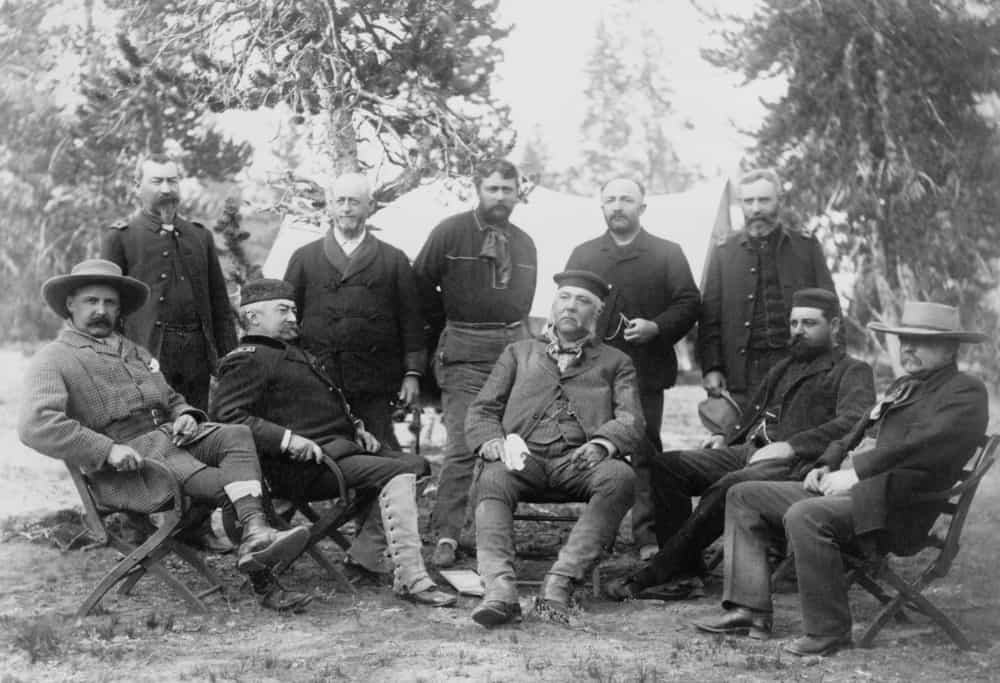
Slim-fitting suits became popular in this decade. Embellished waistcoats were quite trendy at this time because pocket watches were incredibly trendy. It became the fashion to wear the suit jacket unbuttoned to allow the waistcoat and watch chain to show.
Waistcoats were low-cut and had a deep V shape during the first half of the decade. By the latter half of the decade, the U shape had become popular. Waistcoats were double-breasted. Striped pants were incredibly trendy at this time, particularly bold stripes that really stood out.
Suspenders were the accessories of choice for trousers at this time. Many different styles were available. No well-dressed man would go without his suspenders in this era.
1890s

Ready-made and mass-produced clothing were available in the 1890s, opening up a lot of options in style. Jackets became short at this time, both in the waist and the sleeves. The sleeves were also narrow and the jacket was very close-fitting. Slim lapels were in. Jackets were worn buttoned to the top.
It was popular to wear dark-colored jackets with light-colored trousers. The pants were close-fitting at this time. Shirt collars were small and stiff, with little points on either side of the throat.
1900s

The Edwardian era began with pretty ho-hum fashion. Men’s suits were made with durable, woven fabrics dyed in dark colors. Suit jackets had slim lapels and high shirt collars were trendy at this time. Three-piece suits were more popular than their two-piece counterparts. Suit vests were either single- or double-breasted.
Jackets were long and made with an asymmetrical cut because tailcoats were popular. This particular decade was incredibly strict, fashion-wise. What a man wore was dictated by the time of day. Men wore their morning coat until noon, then changed into a lounge suit until six pm. After six, a man slipped into his evening clothes. That meant paring a dinner jacket with trousers. No well-dressed man would lack at least one morning coat and a separate dinner jacket at this time. The rigid styles of the day made the morning suit a necessity for the sharply-dressed male.
Bow ties, neckties and ascots were all popular neckwear and men wore a variety of hats, including top hats, bowler hats and boater hats to mix and match with their morning coat or dinner coat.
1910s
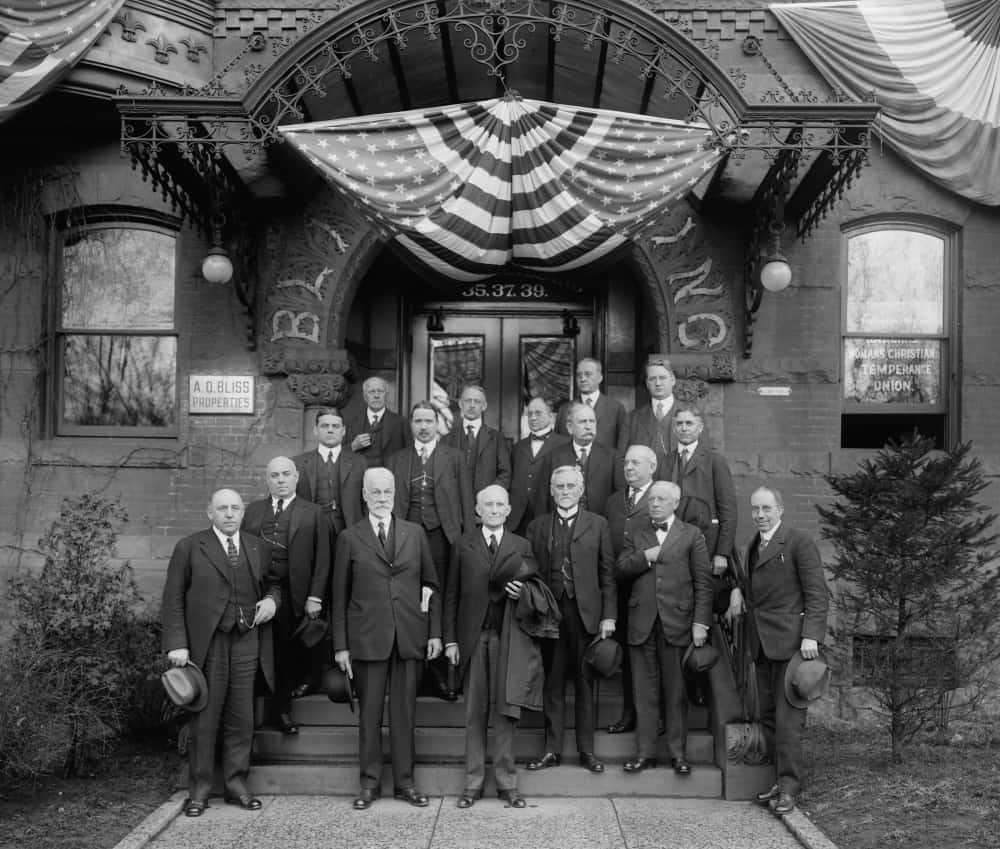
Suit jackets were very long at this time, usually falling below the hips in styles more like the frock coat looks of the past. The fabric was very heavy and durable. Darker fabric was in but brown was more popular than black. Casual suits were also made in patterns more often than not, featuring checks and plaids.
Lighter colors came into fashion in this decade as well. Pants were made in straight-cut styles and cuffed at the bottom. Shirts were worn with very crisp, high collars. Bold stripes were in style. They appeared on suits, shirts and ties, though not always all at the same time.
Short suits
Short suits were the norm for English school uniforms at this time, as it was the fashion for all boys to wear short pants until they became older and reached manhood. Mature men would never wear shorts or short suits at this time. That all changed in 1910, when the British Army introduced a warm weather uniform using short pants. Shorts were soon accepted into male fashion and today, short suits are trending as a hot summer look. Many modern men don’t know they are wearing a style that was hot more than a century ago!
Suffragette suit
The so-called suffragette suit also appeared in this decade. This was created by the American Ladies’ Tailors’ Association. It had a blouse, jacket and an ankle-length skirt that was divided so that it looked like a pair of pants or trousers. The suffragette suit was perhaps the first mass-produced pantsuit design for women.
1920s
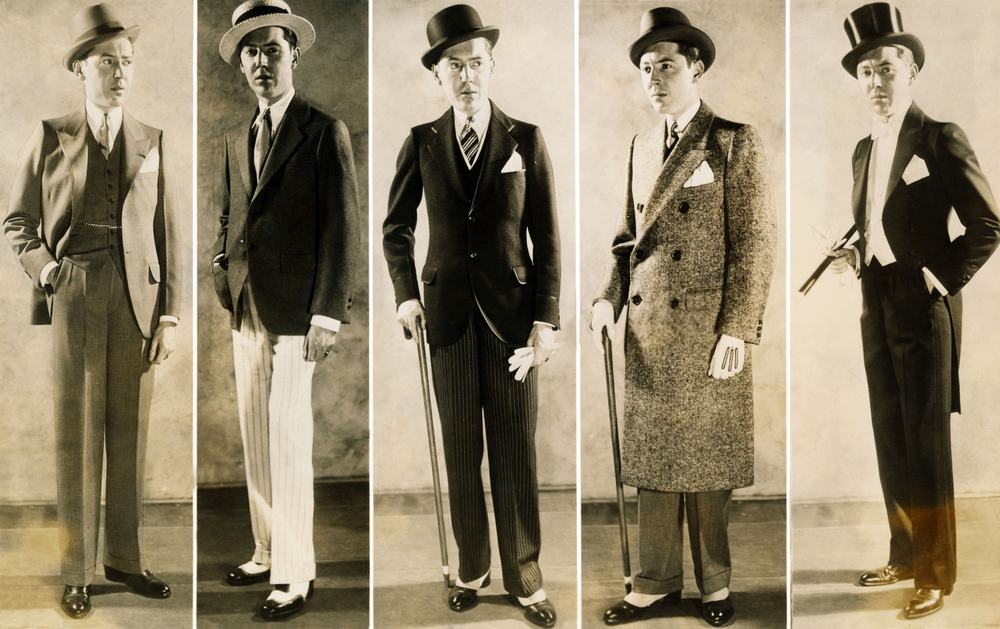
Fashion had a bit more flare in the 1920s. Clothing was brighter and more embellished. Women were wearing shorter skirts and going to nightclubs and men were wearing much flashier suits in order to impress them. Color was suddenly introduced into men’s suits in a big way. In the past, men’s suit looks were commonly seen in dark shades of gray, blue and black. In the 1920s, suits became bright. The white suit appeared in a big way in fashion and the drama of the look made it a fashion staple.
Being in style
Men’s suits were heavily embellished at this time and accessories for them became very trendy. Tie bars, decorative ties and colorful shirts came into fashion. Bow ties were also super trendy at this time.
The pants were high-waisted and baggy, paired with jackets that were somewhat looser than the styles of the previous decade. To match the high-waisted pants, jackets were cut very high at the waist, with somewhat cinched-in styles popular at the start of the decade. This created an elongated, slim silhouette that was very trendy at the time. Pants were made in very straight styles, with no flaring or tapering at the end, with sharp creases in the front. Sometimes, they were finished with short cuffs at the bottom. Belts were favored over suspenders as a means of keeping suit pants in place.
Jackets were made with sloping shoulders in a tight fit around the waist. Spread collars and wider tie knots were paired with suits to create the distinct look of the era.
Double-breasted waistcoats were in fashion at this time. These were paired with single-breasted jackets that were finished with notched lapels.
1930s

The Great Depression left people with no money and very little hope, so style definitely wasn’t a concern at this time. Men’s suits reflected the spirit of the decade: dark colors and simple designs. Wide leg pants were paired with the wide, double breasted suit styles.
Drape suit
Suit jackets were heavy at this time, with wide shoulders. Jackets were somewhat long, around hip-length, in a style more like suit coats than suit jackets. Pants sat very high at the waist and were made to be very full.
The style was known as the drape suit or the drape cut because it was so heavy and tended to sort of hang on the body. The style was popular because it created a sort of bulky, muscular shape and the heavy fabric did not wrinkle easily, so everything hung in straight lines. The silhouette was distinctly masculine, with broad shoulders, small waists and tapering, long legs.
Pants sat high on the waist, above the belly button, and had pleats on the front.
The suits were defined with a slight tapering at the bottom of the legs. This decade is considered to be the “golden age of classic menswear,” according to Gentleman’s Gazette.
Tuxedo style
Marlene Dietrich, another actress who was famous for shattering gender roles, wore a tuxedo and top hat while performing during this decade. At this time, women’s suits were made with skirts and matching jackets. Coco Chanel designed the first Chanel suit, a skirt and jacket, in the 1910s. But Marlene Dietrich helped to redefine what women’s suits really were. It wasn’t the first time a woman wore a tuxedo, but it was the first time a woman gained huge attention for doing so.
1940s
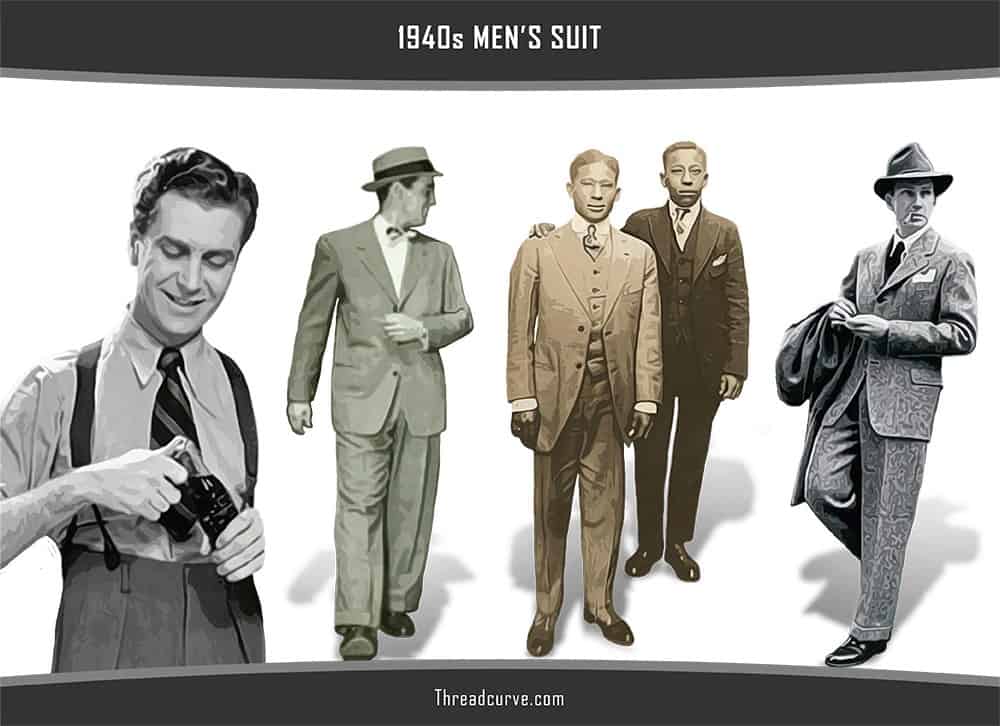
Historic events often have a way of shaping the history of suits and of fashion in general. This was certainly the case in the 1940s.
WWII made times tough all around. There were shortages of everything, including fabric used to make suits. Rayon suits began to appear for the first time in this decade, replacing the hard-to-get tweed and wool. Even with the shortages of fabric, lapels were very wide at this time.
Suits of this era had a distinctly minimalist look, with very little embellishment. Gray flannel suits were ubiquitous and remain a staple of the decade. Suits were single-breasted and paired with much slimmer pants than the previous decade. Slimmer cuts had to be used to save on material.
Vests and waistcoats were not worn as much, probably because they took too much extra material. Suits were extremely slimmed down due to war rationing. They lacked pocket flaps, cuffs and vests. Ties were very big in this decade, used to express individuality and creativity.
The zoot suit
In contrast to this minimalist, conservative style, the 1940s is known for another style of suit that has since become a fashion cult classic: the zoot suit. These suits were made with extremely baggy pants that had a low crotch and big, oversized jackets that had a long cut and wide shoulders. The shoulders were padded to add to their size. Zoot suit styles were extravagant and excessive, a sharp contrast to the conservative styles that were also common in the decade. They took so much fabric to make, people even said that zoot suit looks were unpatriotic.
Zoot suits have the distinct dishonor of having a horrific historic event named after them. The zoot suit riots occurred in June 1943 and were marked by a series of violent altercations involving civilians and off-duty police officers.
Though zoot suits were popular in the 1940s, the look really began in the New York dance halls in the 1930s. Loose-fitting clothing was easier to dance in, so men began wearing baggy trousers and jackets. This led to the zoot suit look, which caught on with young people living in big cities. With wartime putting a strain on resources and materials and with emotions running high, zoot suits were seen as clothing worn by delinquents and evildoers. They were linked to gang members in Los Angeles.
Zoot suit riots
In June 1943, many soldiers and Marines were stationed in LA, a city that had a high population of Mexican American young men. The zoot suit look was particularly popular with younger men at the time and Mexican Americans embraced the style in great numbers. The two groups had a clash on May 31. On June 3, a large group of Navy servicemembers walked through downtown LA brandishing weapons and attacking men wearing zoot suits.
Several riots resulted. Many people were injured and arrested. The riots continued for several days, spilling out from downtown LA into surrounding neighborhoods. Thousands of people were ultimately involved in the riots.
The riots ended on June 8, when military personnel were banned from leaving their barracks. The Los Angeles City Council banned zoot suits the very next day.
Luckily, no one was killed in the zoot suit riots.
Independent woman
As for women’s suits, actress Katherine Hepburn got headlines around the country when she appeared in public wearing a suit with slacks, rather than a skirt. It was called a slack suit, similar to the way suits for women continue to be defined as trouser suit styles.
1950s
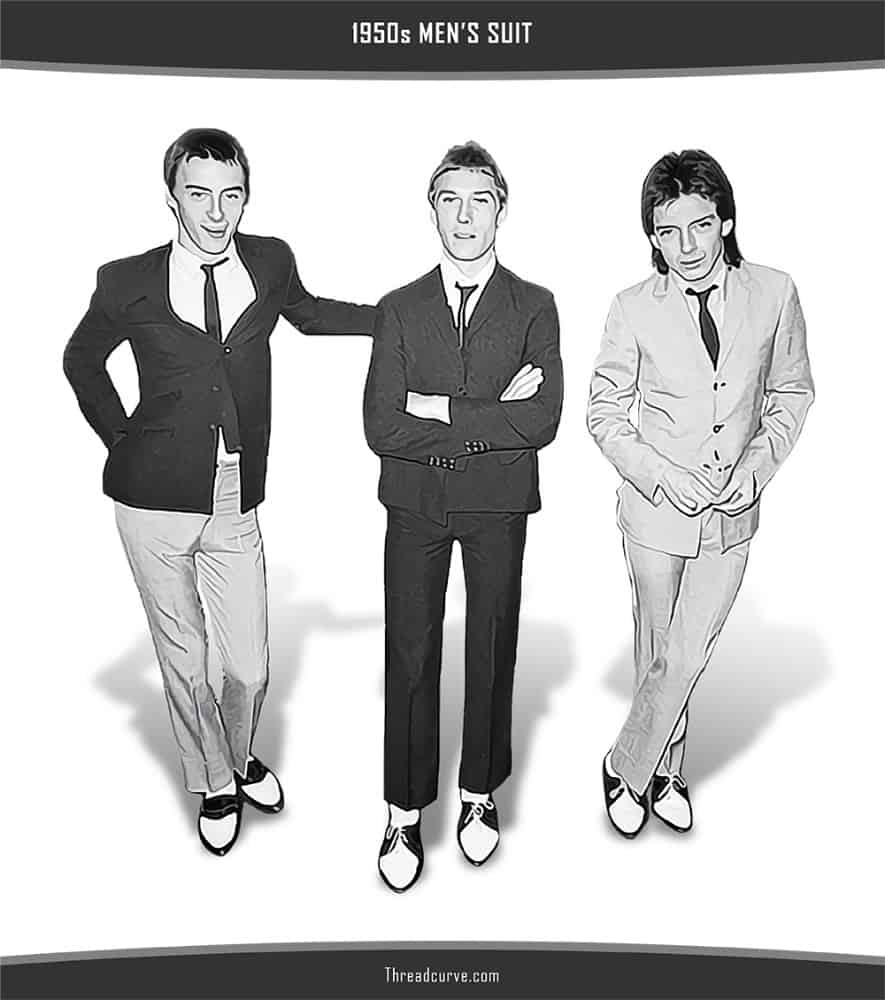
Dark colors were in during the 1950s. Dark suits were worn with dark ties. Shirts were very bright white, with pocket squares that matched. Lapels were slim but jackets were worn wide, loose and big around the shoulders and waist. Even the ties were skinny. Suits were made without shoulder pads, shirt collars got smaller and even hats had narrower brims.
Pants were pleated and wider than they had been in the previous decade. Suit jackets were single-breasted and had no padding to showcase the natural silhouette. Jackets had very high button points, making for short lapels. Rayon and nylon were available for the first time in this decade, which brought in new options for suit fabric.
The youth of the day didn’t want to wear the same suit styles as their fathers and grandfathers. Younger men started wearing the mod suit, a very slim-fitting style with narrow lapels. If you’ve seen the Beatles in their matching black suits appearing on the Ed Sullivan show, you’ve seen the mod suit.
1960s
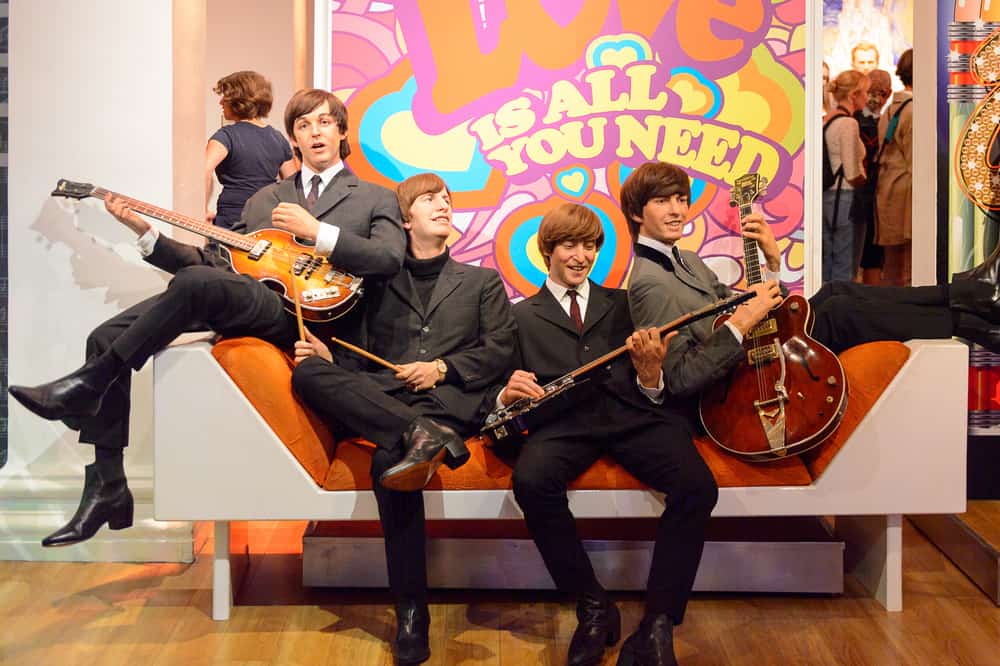
Style took a turn in the 1960s. The country found itself divided over the issue of Vietnam. Counterculture exploded onto the style scene and suits were not left out. Two distinct types of suits were trendy in this year: dark, conservative suits with pinstripes and neat, crisp pocket squares or bold and bright-colored suits made with flared, bell bottom legs and nipped-in waistlines.
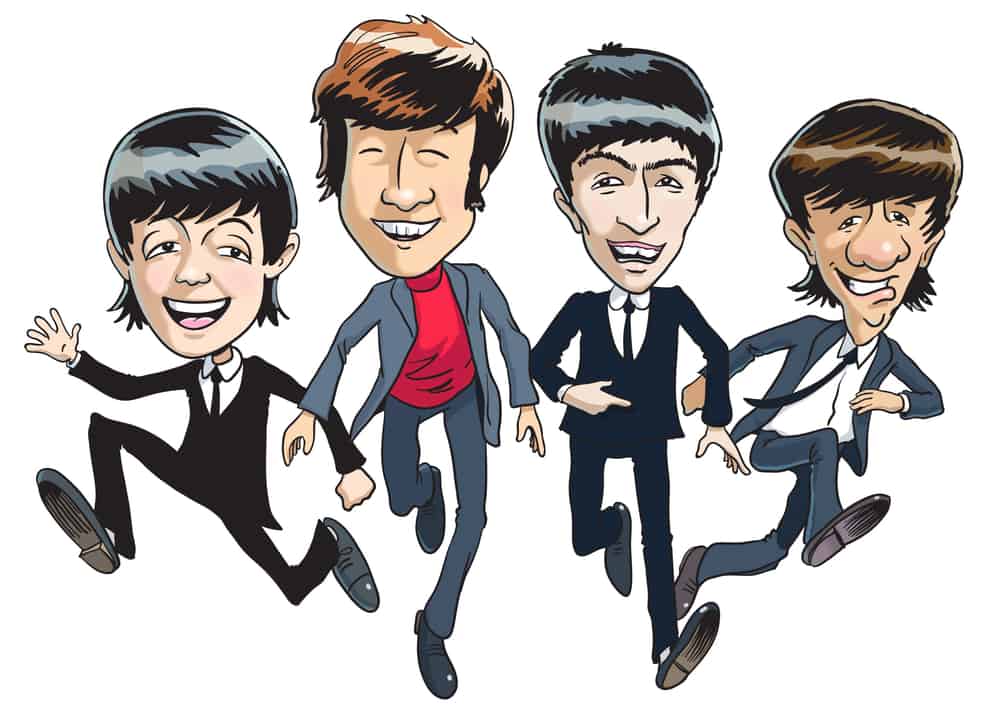
Pants were narrow and close-fitting, tapered at the bottom. Ties were narrow and designed in conservative styles. Suit fabrics were heavy in all styles at this time.
1970s

Some decades of style can possibly be confused with other eras in fashion history, because suit trends tend to come and go. This is not the case with the 1970s. You know when you’re looking at a suit from the 1970s.
This is when suits truly got flashy. The suits were close-fitting around the torso but with flared legs and wide lapels. Shirt collars were also wide at this time. Suits became more casual, worn for an evening out just as much as they were worn for a day at the office.
Bright colors marked the suit style of the decade. It was anything goes in the color and pattern department, with bold prints and vivid shades filling up the discos. Clubbing was the hot thing to do and everybody needed something to wear while they were doing it. The leisure suit was in and the look has become synonymous with the decade itself. Synthetic fabrics, especially polyester, were popular in suit design.
Wide ties and colorful three-piece suits were highly popular and made in bright tones.
1980s
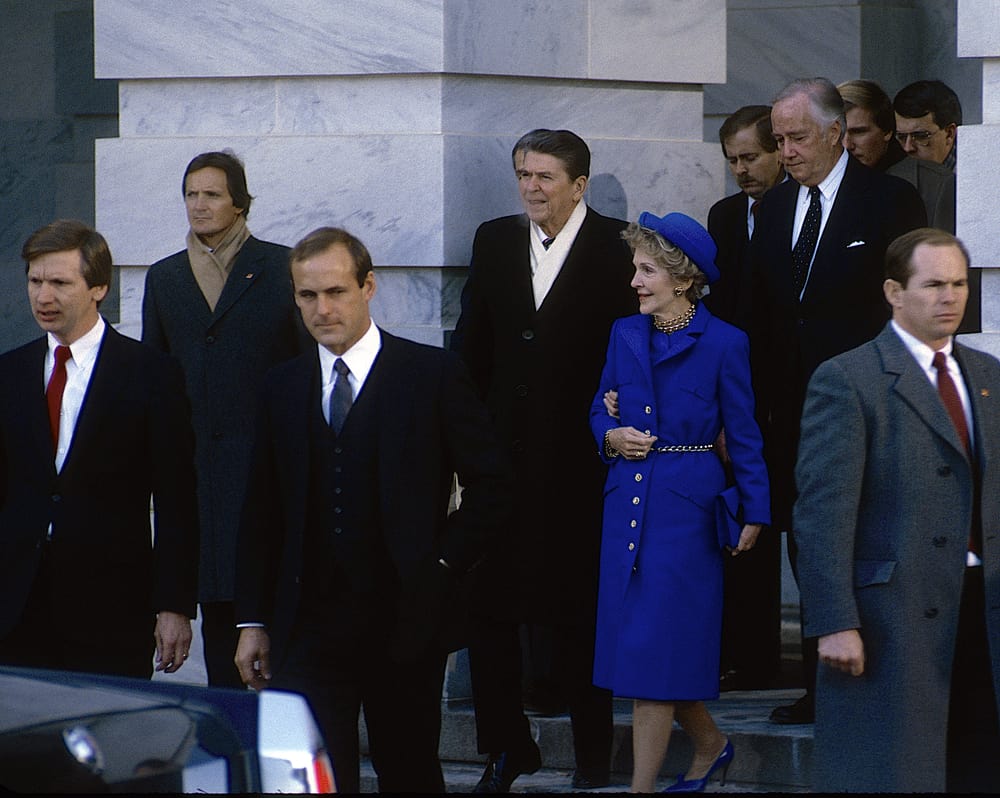
In a break from the vivid, flashy styles of the previous decade, the 1980s took a sharp turn to the right style-wise. Suits became super conservative. They became power suits. The power suit dominated the decade, in fact. Many fashionable men had at least one pinstripe suit and a bold-colored power tie to go with it.
The conservative suits in this era were made in dark colors. Pinstripes and patterned tie styles were popular, along with colorful pocket squares. Suits were cut with a low button point on the jacket. Double-breasted jackets were incredibly popular. Lapels were wide and jacket cuts were somewhat long. Suspenders also caught on in the style scene at this time.
The contrast to this was the more casual suit styles seen on TV shows like “Miami Vice.” Bright colors were still seen but they were softer. Pastels were popular at this time, along with bright whites. Casual suits could be worn with open shirt collars and the sleeves rolled up for a super cool look. Well…they thought it was cool, anyway.
1990s
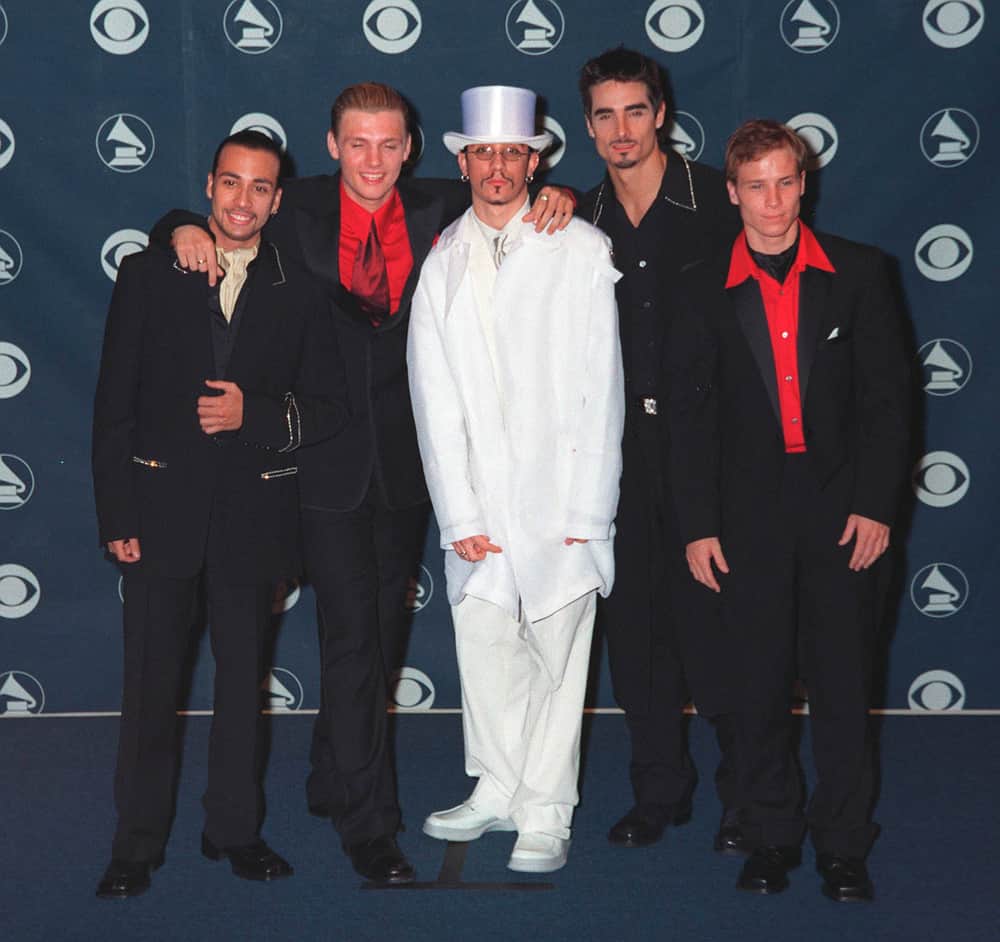
Fashion had a bit of trouble finding its way in the 1990s. It was in that awkward in-between phase, trying to come out of all the fashion mistakes of the 1980 and move toward the millennium with a fresh, modern take. The result was…well, a bit of a mess.
Suit jackets became somewhat big and boxy at this time, a return to the more “suit coats” look of previous decades. Extremely wide lapels were in, shirt collars were long and jackets had a very low button point. Pants were boxy to match the jackets, made in baggy styles. For some odd reason, wearing suit pants a little too long was trendy. This left an excess of fabric around the ankles. And yes, seriously, this is the look that was in.
2000s
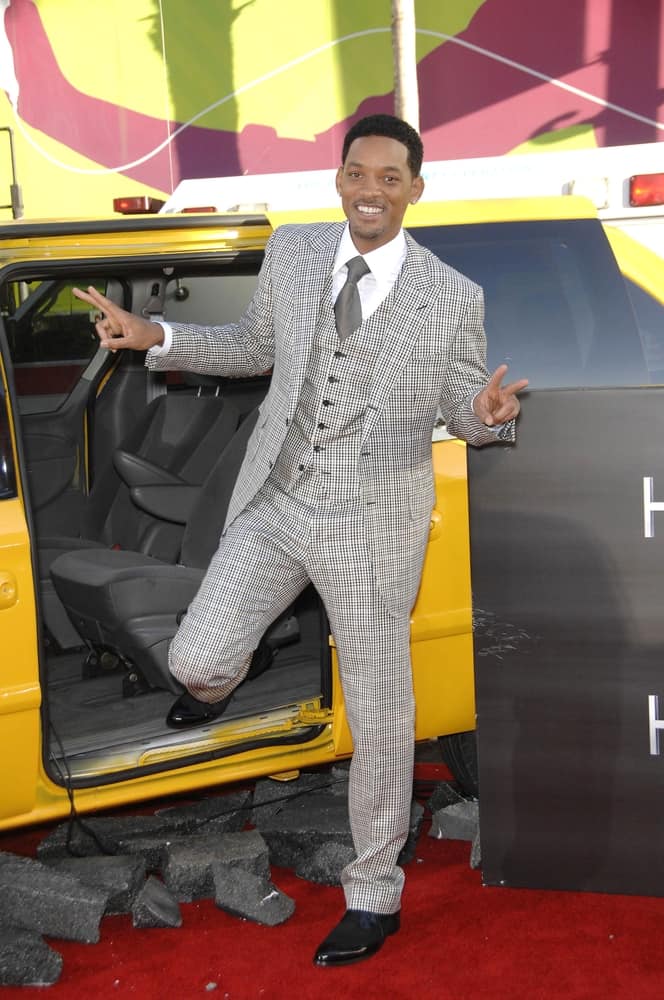
Suits greatly slimmed down in the 2000s because making them any bigger probably wouldn’t have been possible. More natural cuts were in, taking fashion back to a minimalist style that hadn’t been seen in men’s suits for decades.
The suits got slimmer and shorter at this time, with briefer suit jackets that had a higher buttoning point. Pants were hemmed to be at ankle length or actually even shorter. Lapels also got narrow to match the slimmer silhouette.
2010s

Slim styles were still in during this decade, but lapels featured a higher gorge and the buttoning point rose up a bit as well. Jackets were cut short during this decade. Very fitted, well-tailored looked carried the decade.
Retro suit styles were in during the 2010s thanks to shows like “Mad Men.” Slim-fitting suits in dark grays and severe blacks were everywhere. Sedate ties in solid colors or stripes were cut in skinny styles. That’s how the decade started, anyway. Toward the middle and end of the 2010s, men’s fashion took a turn to the left.
More creative suit styles were seen toward the end of the decade. Highly structured suits with bright contrast were in and flowy, airy materials were seen in suitmaking in a sharp contrast from the wools and linens of the past.
2020s

Slim-fitting jackets are back in style in the 2020s. Jacket lengths are short, falling somewhere between the waist and the top of the hips. Jackets are fitted with slightly cinched waists, straight arms and narrow, notched lapels. Button points are low and pocket squares, once so integral to men’s fashion, are appearing less and less.
Pants are trending more toward slim cuts and usually have sharp front creases. Narrow ties are in style, paired with shirts with medium collars that have a wide spread.
One of the trendiest modern suit looks in this decade is the gray, two-button suit. All of Hollywood’s best-dressed men are wearing gray two-button suits in classic tailoring.
Suit styles
Today, suit aficionados will tell you that some countries have their own distinct style characteristics. Experts can tell the difference between an Italian suit, an American suit and a British suit, for example.
The modern British suit was refined by tailors on Savile Row, which has been the center of fashion in London for decades. London is still known for bespoke tailoring and bespoke suit styles. The modern British suit has a tailored look and a tapered waist. Precision tailoring is a mainstay of the British suit style. A tailored suit look will always be popular in Britain.
The modern American suit really has its roots in the 1920s, when flashy style ruled the day. The sack suit is considered to be a classic American suit because it became such a popular look in the U.S., worn by everyone from the upper class Ivy Leaguers to everyday American businessmen. The loose sack style made it easy for men with all body types to wear the American suit. This style was also affordable to mass-produce. American suit looks continue to have a little less tailoring with somewhat straight, loose fits.
The Italian suit really came to fame in the 1950s, when the Italian suit style was really showcased for the first time. The fashion house Brioni debuted their “Roman style” suit in 1952. The style became famous in 1953 when Gregory Peck wore Brioni suits in “Roman Holiday” while starring alongside Audrey Hepburn.
Italian suit styles are made to be lightweight to counter the warm Mediterranean climate. These suits are very tailored and made to fit slim. They are tapered at the waist and have little to no padding in the shoulders. The pants are fitted through the hips and typically slim in the legs. Italian suit styles are somewhat flashy, often featuring pinstripes, bright buttons and a lot of elements that are made to draw the eye.
Related: Men’s Suit Stories Online | Types of Men’s Suits
References:
An Agreeable Tyrant: 1800-1810
Articles of Style: A Brief History of Men’s Fashion
Black Lapel: British vs. American vs. Italian Suits
Esquire: The 2010s Is the Decade We Finally Stopped Obsessing Over How a Man ‘Should’ Dress
Esquire: The Long, Proud History of the Short Suit
GQ: The History of the Suit by Decade
Gentleman’s Gazette: History of the Suit: The Evolution of Menswear from 1800 to Today
Gentleman’s Gazette: Late Victorian Era: Full-Dress & Informal Dress
Gentleman’s Gazette: Regency Evolution: Dress Details
He Spoke Style: How Beau Brummell Invented Modern Men’s Style
Love to Know: 1900’s Fashion
Love to Know: Business Suit
The Met: Suit
Ties: 100 Plus Years of Men’s Fashion
Ties: The Suit: A Modern Man’s Guide
The Trend Spotter: A Guide to Men’s Suit Styles and Details
The University of Vermont: Men’s Clothing
Time Toast: 1810 Fashion Decade Project
Victoria and Albert Museum: History of Fashion 1840 – 1900
Victoriana: Men’s Clothing 1840s
Victoriana: Victorian Clothing for Men from Harper’s Bazaar




